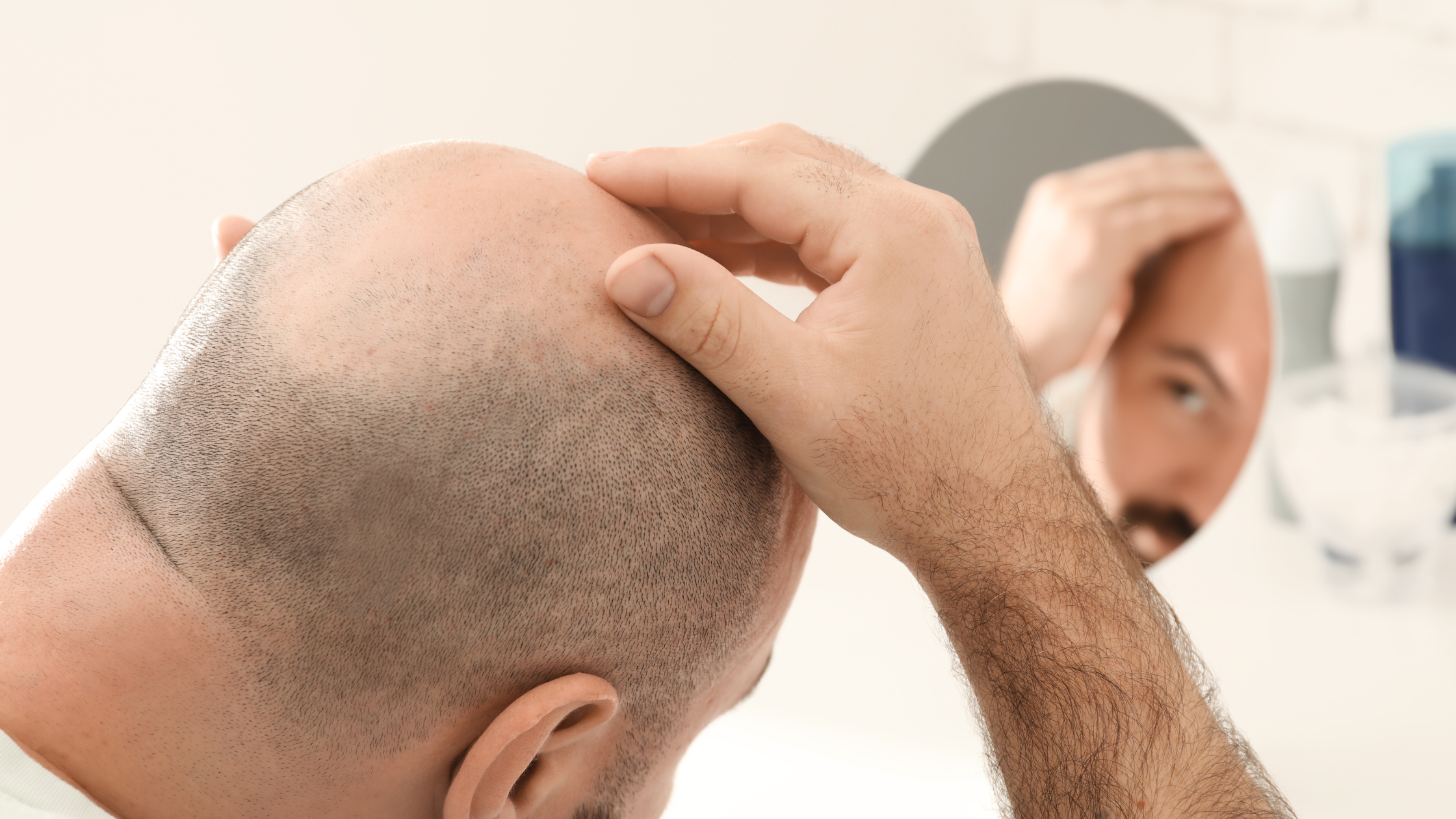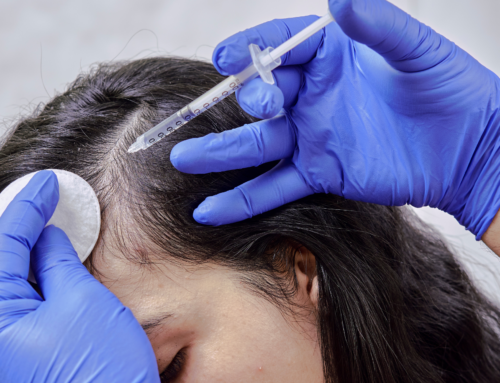MYTH #1: Bald men have more testosterone.
FACT #1:
Baldness affects millions of men worldwide. It’s characterized by the loss of hair due to various factors. One of the most significant factors in male pattern baldness is the hormone dihydrotestosterone (DHT).
Research suggests that people, especially men, with baldness have a higher percentage of follicles that are genetically susceptible to DHT. The hormone plays a crucial role in the shrinkage and miniaturization of hair follicles, leading to the progressive thinning and, ultimately, the loss of hair.
DHT is a byproduct of testosterone, and it is believed to bind to the receptors in the scalp’s hair follicles, causing them to shrink over time. The process shortens the hair growth cycle, resulting in finer and shorter hairs until eventually, the follicles cease to produce hair altogether.
Understanding the role of DHT in baldness has led to the development of various treatments aimed at slowing down or reversing hair loss. Medications like finasteride and minoxidil work by blocking the production of DHT or stimulating hair follicles to promote hair growth.
Ultimately, while DHT plays a significant role in male pattern baldness, it’s just one piece of the puzzle. Further research into the complex interplay of genetics, hormones, and environmental factors is essential for developing healthy, non-invasive effective treatments and interventions for baldness in the future.
MYTH #2: Hair loss is passed down from your mother’s side.
FACT #2:
Unlike conditions caused by a single gene mutation, such as cystic fibrosis, genetic hair loss is polygenic, involving the interaction of numerous genetic factors.
At the beginning of our understanding lies the recognition that genetic hair loss is not solely inherited from one parent but can be passed down from both the mother’s and father’s sides of the family. This realization sets the stage for unraveling the intricate genetic web contributing to baldness.
As we dig deeper into the genetics of hair loss, we discover many genes, each of which plays a role in determining a person’s susceptibility to the condition. These genes interact in a complex dance, influencing the onset, severity, and pattern of hair loss experienced by a person.
The inheritance pattern of genetic hair loss varies from person to person. Some men inherit a combination of genes which predispose them to baldness from both sides of the family equally, while others inherit more genes from one parent than the other.
This multi-faceted genetic interplay shows how challenging it is to predict and understand the inheritance aspect of genetic hair loss. While your family history remains a significant risk factor, it isn’t the sole determinant. There is so much more which research into genetics needed to truly understand the causes and conditiones of genetic, or male pattern baldness.
Understanding the complexity of this genetic landscape is part of developing a personalized approach, like we have developed at Cellustrious to prevention and treatment, paving the way for more effective interventions in the future.
MYTH #3: Rogaine works for men and women in the same way.
FACT #3:
Rogaine is only effective for androgenetic alopecia, (male pattern baldness).. The jury is out when it comes to its effectiveness for women.
A topical solution – also known as minoxidil – Rogaine has gained popularity as a go-to remedy for male pattern baldness, medically termed “androgenetic alopecia.” However, its effectiveness applies only to this specific type of hair loss.
At the outset, Rogaine appears to be a promising solution for those experiencing male pattern baldness. Its mechanism of action involves stimulating hair follicles, promoting hair growth, and slowing down further hair loss.
Yet, as we delve deeper into the realm of hair loss, we encounter a myriad of conditions that Rogaine has failed to address. Immune-based disorders like lupus, infections such as syphilis, hormonal changes during menopause or pregnancy, and the hair loss associated with chemotherapy all lie beyond Rogaine’s scope of effectiveness.
The middle ground of uncertainty emerges when considering Rogaine’s efficacy for women. While it has been approved by regulatory agencies for use in female pattern hair loss, the jury remains out on its effectiveness. Some women report positive results, while others find little to no improvement in their hair growth.
Over time, research has shown Rogaine’s effectiveness is limited to androgenetic alopecia in men, and has been shown to wane over time. While it may offer some help to women with hair loss, its efficacy remains uncertain. And, for people whose hair loss stems from other underlying causes, Rogaine proves ineffective.
In the landscape of hair loss treatments, Rogaine may serve as a valuable tool for some, but it falls short for many others. As researchers continue to unravel the complexities of hair biology, new treatments tailored to address the diverse causes of hair loss are emerging, offering hope to those seeking other solutions.
MYTH #4: Hair loss doesn’t affect a man’s emotions.
FACT #4:
Patients, both male and female, with alopecia are often affected with major depression and generalized anxiety disorder. Also, some studies show that patients with alopecia had higher rates of psychiatric illnesses, such as anxiety disorders, depression, and social phobia, when compared to the general population.
In the realm of dermatology, alopecia, or hair loss, extends beyond its physical manifestations to impact the mental well-being of affected individuals. People grappling with alopecia find themselves dealing not only with the physical changes to their appearance, but often the burden of mental health challenges.
Research also reveals a significant association between alopecia and mental health disorders, particularly major depression and generalized anxiety disorder. For those living with alopecia, the emotional toll of hair loss often manifests in symptoms of sadness, hopelessness, and excessive worry, which increases their psychological distress.
Recognizing the psychological burden of alopecia prompts a call to action. We must address both the physical manifestations of hair loss and the emotional and psychological needs, as well.
The link between alopecia and mental health disorders is undeniable. By acknowledging and addressing the psychological impact of alopecia, medical and healthcare providers can help patients navigate things by offering them fostering hope and healing.
If you’re dealing with androgenetic alopecia and would like to talk to a certified trichologist, reach out to Cellustrious® for our non-toxic, plant-based options that have a 90% success rate.
You can book a free 15-minute call with a Cellustrious® trichologist, here.





